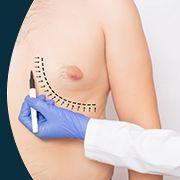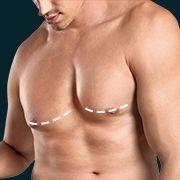Recovery Timeline After Gynecomastia Surgery: What to Expect
In This Article
Recovery Timeline After Gynecomastia Surgery: What to Expect
Indu
Updated on February 06, 2024
Medically verified by Dr. Arya
Fact checked by Dr. Pournami

Cosmetic
7 min read
You already might know what gynecomastia is? If you don’t, it is a condition in which the breast tissues in men or boys are over developed or enlarged. It causes your breasts to grow larger or sometimes uneven.
Are you facing a similar problem? Wondering how to treat and get over this condition?
Well, gynecomastia surgery under the supervision of an expert doctor could be the solution.
Want to know more about this surgery - recovery timeline and what to expect? You’re in the right place.
In this blog, we will explore gynecomastia surgery, its recovery timeline and what to expect during that period. Let’s dive right into it.
Why Gynecomastia Surgery?
If you are someone with gynecomastia, you would know how much it affects your self confidence and self image. You might be embarrassed to go shirtless even in front of your loved ones and even if the situation demands it.
Does exercise help? In most of the cases, the answer will be a no, though it might be helpful to an extent. A surgery would be the permanent answer. This surgery will definitely help boost your body image and self confidence.
What Is Gynecomastia Surgery?
This is a cosmetic surgery procedure.
Through gynecomastia surgery, your excess breast tissues and fat are removed. Gynecomastia surgery procedure usually includes liposuction, excision or a combination of both.
Your doctor/surgeon can confirm which procedure is best suited for you.
What Are The Different Procedures Included In Gynecomastia Surgery?
Gynecomastia surgery usually includes liposuction, excision or a combination of both.
The following table showcases the major difference between the three procedures.
| Liposuction |
|---|
| A minimally invasive procedure |
| Excess fat is suctioned out using a thin tube called a cannula |
| Effective for treating gynecomastia caused primarily by excess fatty tissue |
| Reduce chest size by eliminating localised fat deposits |
| Sculpt and contour the chest to create a more masculine appearance |
| Utilises small incisions, minimising scarring |
| Glandular Excision |
|---|
| Involves the surgical removal of glandular tissue from the chest, often through incisions made along the edge of the areola or in natural chest creases |
| Necessary when gynecomastia is caused by overdeveloped glandular tissue |
| Address overdeveloped glandular tissue contributing to breast enlargement |
| Achieve a flatter and more contoured chest appearance |
| Can enhance symmetry and proportionality of the chest |
| Combination (Liposuction + Glandular Excision) |
|---|
| Integrates liposuction and glandular excision to address both excess fat and glandular tissue |
| Offers a customised approach based on the specific characteristics of gynecomastia |
| Remove excess fat and glandular tissue for comprehensive results |
| Achieve a balanced and aesthetically pleasing chest contour |
| Tailor the surgical approach to the unique needs of each patient |
| Minimise both fat and glandular tissue, addressing multiple contributors to gynecomastia |
How To Prepare For Gynecomastia Surgery?
Like any other surgery, for gynecomastia too, you need to be prepared beforehand. This will make your recovery procedure easier and smooth.
Here are some of the general instruction your doctor will give you :-
-
If you are a working adult, take enough time off from your work for both surgery and recovery period.
-
Do not smoke for at least 2 weeks before the surgery.
-
You should let your doctor know about any medications you are taking, even if it is some kind of herbal supplement.
-
Do not drink for at least one week prior to the surgery.
-
Usually, patients who have undergone gynecomastia surgery are required to wear a compression garment. Your doctor will advise you on which type of garment you will need to purchase.
Normally, on the day of surgery, you would have to avoid eating for 6 hours prior, and drinking for 2 hours prior.
Surgeons would usually recommend taking a shower before the procedure and wearing some dark, loose, comfortable clothing.
 9 min read
9 min readThe Advantages of Choosing Mykare Health for Gynecomastia Surgery
 6 min read
6 min readIdentifying The Ideal Age For Gynecomastia Surgery
 6 min read
6 min readPre and Post Gynecomastia Surgery: Essential Things to Know
Book Your Consultation Now
What To Expect Immediately After the Surgery?
-
This is the most crucial phase in your journey towards recovery.
-
This is the most crucial phase in your journey towards recovery.
What Would the Next Few Days Be Like?
| After 2-3 Days |
|---|
| You will experience pain, tightness or numbness |
| Take the Pain medication that your doctor described if there is any kind of discomfort |
| Some of you may experience numbness. This could depend on the type of anaesthesia applied on you |
| Depending on the anaesthesia, you may also experience nausea |
| Your chest area may appear swollen and this swelling and discomfort can be minimised using a compression garment |
| Don't take a shower for the first 24 hours |
| Don’t involve in any physical activity other than light walking |
| Some of you might have to sleep in an elevated position at a 45 degree angle |
| After 1 Week |
|---|
| Your pain and swelling will be decreased |
| You can go back to your normal life |
| Can be engaged in light exercise- avoid anything that stresses your pecs |
| Wear your compression garment the whole time |
| You might find it difficult to sleep on your back, but don't sleep on your side or stomach yet |
| Visit your surgeon, if the stitches or drain is to be removed |
| After 2 Weeks |
|---|
| There won't be much pain and you will start feeling normal again |
| Can go back to your daily routines-though avoid heavy exercise |
| Can start sleeping on sides or stomach |
| Continue wearing compression garments |
| After 3-4 Weeks |
|---|
| Can go back to your normal exercise routine - don't specifically target your chest area |
| Can stop using compression garments |
| Most of the swelling and bruising will be gone |
| After 6 Weeks |
|---|
| Usually by 6th week your recovery process will be over |
| You can even go back to vigorous exercise routine, depending upon your health |
| Can sleep in any position |
| In the next few weeks, all the swellings(if there is any left) will be completely gone |
How Do I Manage The Pain And Discomfort?
It is normal for you to experience some level of pain, bruise, swelling or soreness.
-
Your doctor will prescribe to you appropriate pain medicines.
-
Applying cold compress in the area undergone surgery will help you relieve from swelling. It will also give some kind of relief.
-
Your surgeon will also ask you to wear compression garments. This is to minimise your discomfort and reduce the swelling.
-
Make sure that you are taking proper rest, and at the same time involved in light movements. Otherwise you will be experiencing stiffness.
-
Communicate with your doctor and talk about your concerns. Strictly follow his/her instructions and take medications on time.
Other Tips for Post Surgery Period
-
You should attend all the follow up appointments. Only then, the doctor can monitor your situation and ensure that you are recovering properly.
-
Your doctor might have given you instructions on how to clean the wound and the surgical site. Follow it, keep the region clean and dry. This will help in avoiding infection. It will also fasten your recovery process and lessen the complications.
-
Follow the dietary restrictions, if you are given any. Otherwise eat a balanced diet and stay hydrated.
The primary goal of gynecomastia surgery is to correct overdeveloped breat tissues.
Surgical techniques include liposuction, glandular excision, and a combination of both.
Preparation for surgery involves taking time off work, quitting smoking, and wearing compression garments post-surgery.
Immediate post-surgery period includes monitoring for stability, dressing changes, and medication administration, with expected discomfort and swelling.
Days 2-3 involve pain, tightness, and swelling; compression garments are crucial.
Week 1 sees decreased pain, return to normal life, and light exercise.
Week 2 experiences minimal pain, resumption of normal routines, and beginning to sleep on sides or stomach.
Weeks 3-4 allow the return to normal exercise and discontinuation of compression garments.
Week 6 marks recovery completion and a return to vigorous exercise.
Pain and discomfort management includes prescribed medications, cold compresses, and the use of compression garments.
Post-surgery tips include attending all follow-up appointments, following wound care instructions, and adhering to dietary restrictions while maintaining hydration for optimal recovery.



